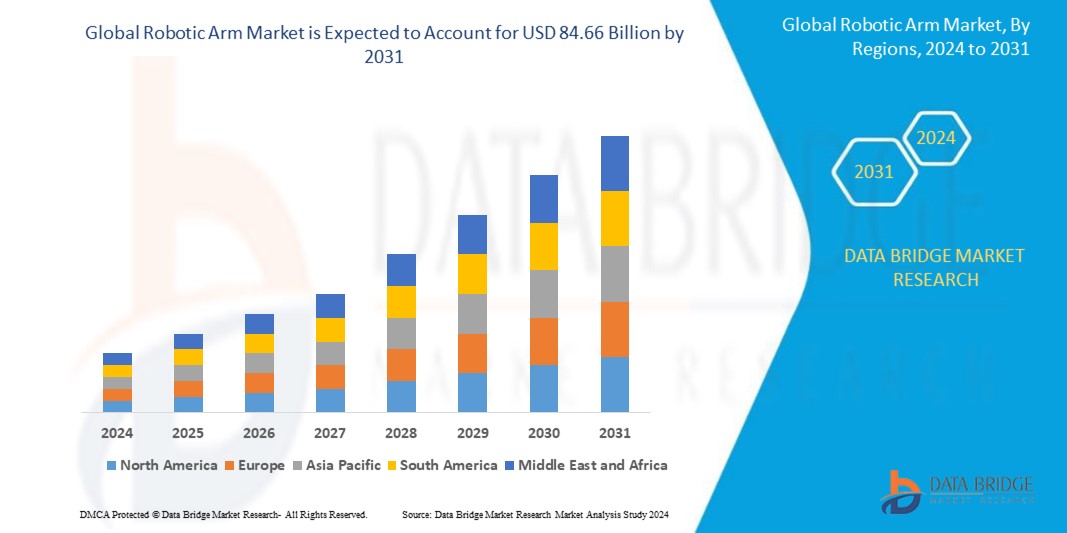

The
is undergoing a significant transformation, with industry forecasts predicting rapid expansion and cutting-edge technological innovations by 2032. As businesses continue to embrace digital advancements and strategic shifts, the sector is set to experience unprecedented growth, driven by rising demand, market expansion, and evolving industry trends.
A recent in-depth market analysis sheds light on key factors propelling the Robotic Arm market forward, including increasing market share, dynamic segmentation, and evolving consumer preferences. The study delves into crucial growth drivers, offering a detailed outlook on industry progress and future potential. Additionally, the report leverages SWOT and PESTEL analyses to assess market strengths, weaknesses, opportunities, and threats while examining economic, regulatory, and technological influences shaping the industry's trajectory.
Competitive intelligence plays a pivotal role in this sector's evolution, with leading companies innovating and expanding across key regions. The latest market insights provide a comprehensive overview of emerging opportunities, investment hotspots, and strategic business approaches.
For businesses and investors looking to stay ahead in the Robotic Arm market, this report serves as a vital resource, offering data-driven insights and strategic recommendations to navigate market challenges and capitalize on future growth opportunities. As 2032 approaches, staying informed about industry trends will be crucial for maintaining a competitive edge in this fast-evolving landscape.
What is the projected market size & growth rate of the Robotic Arm Market?
Market Analysis and Size
The robotic arms is majorly used in manufacturing, where they play a crucial role in tasks such as assembly, welding, and material handling. These robotic arms enhance efficiency, precision, and speed in production processes, leading to increased productivity and cost-effectiveness for industries. Their versatility allows for automation in various sectors, including automotive, electronics, and aerospace, contributing to the optimization of manufacturing workflows and operational performance.
Data Bridge Market Research analyses the global robotic arm market valued at USD 29.89 billion in 2023, will reach USD 84.66 billion by 2031, growing at a CAGR of 13.90% during the forecast period of 2024 to 2031. In addition to the insights on market scenarios such as market value, growth rate, segmentation, geographical coverage, and major players, the market reports curated by the Data Bridge Market Research also include in-depth expert analysis, geographically represented company-wise production and capacity, network layouts of distributors and partners, detailed and updated price trend analysis and deficit analysis of supply chain and demand.
Browse Detailed TOC, Tables and Figures with Charts which is spread across 350 Pages that provides exclusive data, information, vital statistics, trends, and competitive landscape details in this niche sector.
This research report is the result of an extensive primary and secondary research effort into the Robotic Arm market. It provides a thorough overview of the market's current and future objectives, along with a competitive analysis of the industry, broken down by application, type and regional trends. It also provides a dashboard overview of the past and present performance of leading companies. A variety of methodologies and analyses are used in the research to ensure accurate and comprehensive information about the Robotic Arm Market.
Get a Sample PDF of Report - https://www.databridgemarketresearch.com/request-a-sample/?dbmr=global-robotic-arm-market
Which are the driving factors of the Robotic Arm market?
The driving factors of the Robotic Arm market include technological advancements that enhance product efficiency and user experience, increasing consumer demand driven by changing lifestyle preferences, and favorable government regulations and policies that support market growth. Additionally, rising investment in research and development and the expanding application scope of Robotic Arm across various industries further propel market expansion.
Robotic Arm Market - Competitive and Segmentation Analysis:
Global Robotic Arm Market, By Payload Capacity (Less than 500KG, 500-3000KG, 3001KG and Above), Type (Articulated, Cartesian, SCARA, Spherical or Polar, Cylindrical, Others), Axes (1-Axis, 2-Axis, 3-Axis, 4-Axis, 5-Axis, 6-Axis, 7-Axis), End User Industry (Automotive, Electrical and Electronics, Metals and Machinery, Plastics and Chemicals, Food and Beverages, Others), Application (Materials Handling, Cutting and Processing, Soldering and Welding, Assembling and Disassembling, Others) – Industry Trends and Forecast to 2032.
How do you determine the list of the key players included in the report?
With the aim of clearly revealing the competitive situation of the industry, we concretely analyze not only the leading enterprises that have a voice on a global scale, but also the regional small and medium-sized companies that play key roles and have plenty of potential growth.